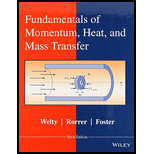
Interpretation: Dimensionless groups to determine the power output is to be discussed.
Concept Introduction: One of the ways to conduct dimension analysis is by using the Buckingham pi method. In this method, some core groups are determined. These core groups contain some fixed variables and some changing variables. However, the ultimate dimensions of these pi groups are zero which means they are supposedly dimensionless.
Answer to Problem 11.1P
Using the Buckingham pi method, the dimensionless expressions are
Explanation of Solution
Firstly, a table is constructed on the variables involved along with their dimensions as shown below.
| Variable | Symbol | Dimension |
| Diameter | ||
| Height | ||
| Density | ||
| Gravitational acceleration | ||
| Angular velocity | ||
| Discharge | ||
| Power | ||
| Efficiency | dimensionless |
With respect to the table above, the dimensional matrix formed is as below.
Next, the rank
Therefore, the number of independent dimensionless groups
Here,
Say,
Based on the data available so far, the following core groups can be proposed.
If it depends only on efficiency thereby making it automatically dimensionless that is
For the rest of the variables, there are some fixed variables and some changing variables. For example, let density, diameter, and angular velocity are common. Then, the rest of the variables are defined in the following manner.
Say,
Using dimensional analysis, the same group may be re-expressed in the following manner.
Upon comparing coefficients of individual dimensions, the following set of equations is obtained.
Hence, the following simplification is obtained.
Simply put,
This means that this particular group may have the following expression.
Say,
Using dimensional analysis, the same group may be re-expressed in the following manner.
Upon comparing coefficients of individual dimensions, the following set of equations is obtained.
Hence, the following simplification is obtained.
Simply put,
This means that this particular group may have the following expression.
Say,
Using dimensional analysis, the same group may be re-expressed in the following manner.
Upon comparing coefficients of individual dimensions, the following set of equations is obtained.
Hence, the following simplification is obtained.
Simply put,
This means that this particular group may have the following expression.
Say,
Using dimensional analysis, the same group may be re-expressed in the following manner.
Upon comparing coefficients of individual dimensions, the following set of equations is obtained.
Hence, the following simplification is obtained.
Simply put,
This means that this particular group may have the following expression.
Want to see more full solutions like this?
Chapter 11 Solutions
Fundamentals of Momentum, Heat, and Mass Transfer
 Introduction to Chemical Engineering Thermodynami...Chemical EngineeringISBN:9781259696527Author:J.M. Smith Termodinamica en ingenieria quimica, Hendrick C Van Ness, Michael Abbott, Mark SwihartPublisher:McGraw-Hill Education
Introduction to Chemical Engineering Thermodynami...Chemical EngineeringISBN:9781259696527Author:J.M. Smith Termodinamica en ingenieria quimica, Hendrick C Van Ness, Michael Abbott, Mark SwihartPublisher:McGraw-Hill Education Elementary Principles of Chemical Processes, Bind...Chemical EngineeringISBN:9781118431221Author:Richard M. Felder, Ronald W. Rousseau, Lisa G. BullardPublisher:WILEY
Elementary Principles of Chemical Processes, Bind...Chemical EngineeringISBN:9781118431221Author:Richard M. Felder, Ronald W. Rousseau, Lisa G. BullardPublisher:WILEY Elements of Chemical Reaction Engineering (5th Ed...Chemical EngineeringISBN:9780133887518Author:H. Scott FoglerPublisher:Prentice Hall
Elements of Chemical Reaction Engineering (5th Ed...Chemical EngineeringISBN:9780133887518Author:H. Scott FoglerPublisher:Prentice Hall
 Industrial Plastics: Theory and ApplicationsChemical EngineeringISBN:9781285061238Author:Lokensgard, ErikPublisher:Delmar Cengage Learning
Industrial Plastics: Theory and ApplicationsChemical EngineeringISBN:9781285061238Author:Lokensgard, ErikPublisher:Delmar Cengage Learning Unit Operations of Chemical EngineeringChemical EngineeringISBN:9780072848236Author:Warren McCabe, Julian C. Smith, Peter HarriottPublisher:McGraw-Hill Companies, The
Unit Operations of Chemical EngineeringChemical EngineeringISBN:9780072848236Author:Warren McCabe, Julian C. Smith, Peter HarriottPublisher:McGraw-Hill Companies, The





